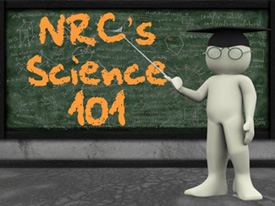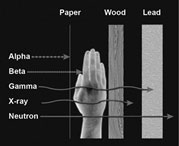Information on Different Types of Light and Reading
What Are The Different Types of Radiations?
Printable Version
The Nuclear Regulatory Commission'due south Science 101: What Are The Different Types of Radiation?
 In before Science 101s, nosotros talked almost what makes up atoms, chemicals, affair and ionizing radiations. At present, let's look at the different kinds of radiation.
In before Science 101s, nosotros talked almost what makes up atoms, chemicals, affair and ionizing radiations. At present, let's look at the different kinds of radiation.
There are iv major types of radiations: alpha, beta, neutrons, and electromagnetic waves such as gamma rays. They differ in mass, energy and how deeply they penetrate people and objects.
The first is an alpha particle. These particles consist of two protons and two neutrons and are the heaviest blazon of radiations particle. Many of the naturally occurring radioactive materials in the world, similar uranium and thorium, emit alpha particles. An example nearly people are familiar with is the radon in our homes.
The second kind of radiation is a beta particle. Information technology's an electron that is not attached to an cantlet. It has a small mass and a negative accuse. Tritium, which is produced by cosmic radiation in the temper and exists all around united states, emits beta radiations. Carbon-14, used in carbon-dating of fossils and other artifacts, besides emits beta particles. Carbon-dating only makes use of the fact that carbon-14 is radioactive. If y'all mensurate the beta particles, it tells you how much carbon-14 is left in the fossil, which allows yous to calculate how long ago the organism was alive.
The 3rd is a neutron. This is a particle that doesn't accept whatever accuse and is nowadays in the nucleus of an atom. Neutrons are commonly seen when uranium atoms divide, or fission, in a nuclear reactor. If it wasn't for the neutrons, you wouldn't exist able to sustain the nuclear reaction used to generate power.
The last kind of radiation is electromagnetic radiation, like 10-rays and gamma rays. They are probably the near familiar type of radiations considering they are used widely in medical treatments. These rays are similar sunlight, except they have more than energy. Different the other kinds of radiation, there is no mass or charge. The amount of energy can range from very low, like in dental x-rays, to the very high levels seen in irradiators used to sterilize medical equipment.
 As mentioned, these different kinds of radiation travel different distances and have dissimilar abilities to penetrate, depending on their mass and
As mentioned, these different kinds of radiation travel different distances and have dissimilar abilities to penetrate, depending on their mass and
their energy. The figure (right) shows the differences.
Neutrons, considering they don't take whatever charge, don't interact with materials very well and will go a very long way. The only way to stop them is with large quantities of h2o or other materials made of very low-cal atoms.
On the other manus, an blastoff particle, considering information technology's very heavy and has a very large charge, doesn't go very far at all. This means an alpha particle can't even get through a sheet of paper. An alpha particle outside your torso won't fifty-fifty penetrate the surface of your skin. But, if you inhale or ingest material that emits alpha particles, sensitive tissue like the lungs can be exposed. This is why loftier levels of radon are considered a trouble in your home. The ability to stop alpha particles and then easily is useful in smoke detectors, because a piffling smoke in the chamber is enough to stop the blastoff particle and trigger the warning.
Beta particles go a petty farther than blastoff particles. You could use a relatively pocket-size corporeality of shielding to stop them. They can get into your trunk only can't become all the fashion through. To be useful in medical imaging, beta particles must be released by a cloth that is injected into the torso. They tin also be very useful in cancer therapy if you can put the radioactive material in a tumor.
Gamma rays and x-rays can penetrate through the torso. This is why they are useful in medicine—to evidence whether bones are cleaved or where there is tooth disuse, or to locate a tumor. Shielding with dumbo materials like concrete and pb is used to avoid exposing sensitive internal organs or the people who may be working with this type of radiations. For example, the technician who does my dental x-rays puts a pb frock over me before taking the moving-picture show. That apron stops the 10-rays from getting to the rest of my body. The technician stands backside the wall, which usually has some lead in information technology, to protect him or herself.
Radiation is all around usa (chosen groundwork radiation), but that is non a reason to be agape. Unlike types of radiation behave differently, and some forms tin exist very useful.
The U.S. Nuclear Regulatory Commission is an contained federal government agency responsible for regulating the commercial use of nuclear materials. This document is free of copyright and can exist reproduced for educational purposes.
![]()
Page Final Reviewed/Updated Th, March nineteen, 2020
Information on Different Types of Light and Reading
Source: https://www.nrc.gov/reading-rm/basic-ref/students/science-101/what-are-different-types-of-radiation.html
0 Response to "Information on Different Types of Light and Reading"
Post a Comment